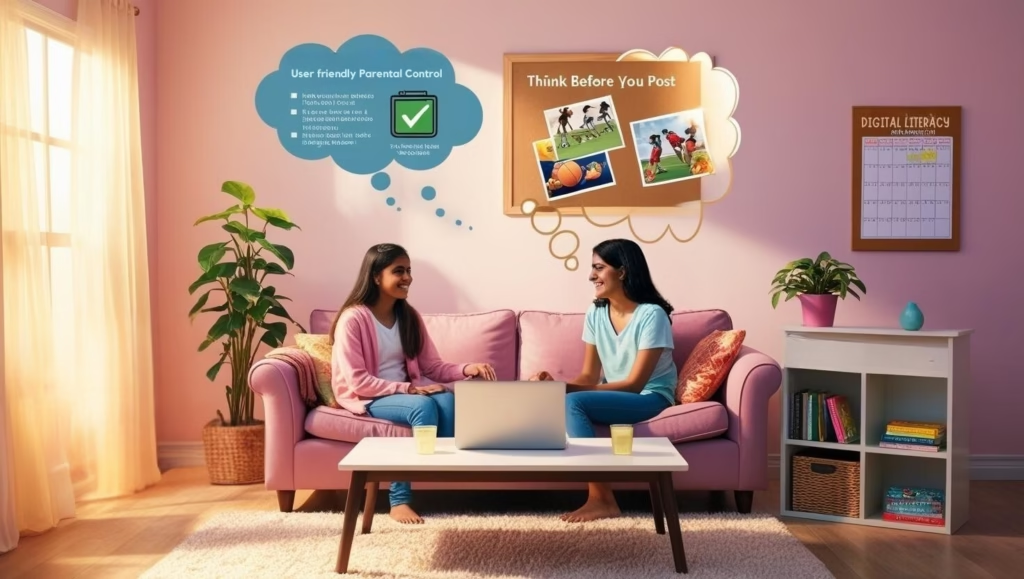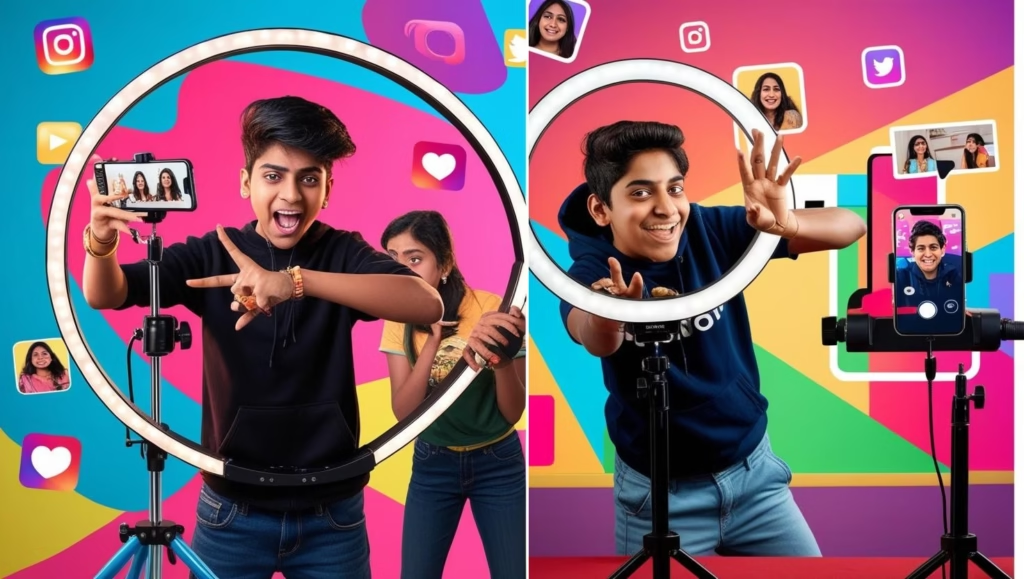Cringe content has emerged as a major trend among Indian teenagers, thanks to the soaring popularity of short-form video platforms like Reels, Shorts, and Moj. These videos, often low in production quality and socially awkward, not only grab massive attention but also fuel conversations about their psychological and cultural effects.
Key Insights
- Cringe content thrives by evoking discomfort, typically marked by awkward scenarios and subpar production quality.
- Platforms for short-form videos have become key channels for distributing cringe content, boosting engagement, especially among teens in India.
- Chasing online fame through cringe content can seriously affect teenagers’ emotions and mental state, leading to issues like lower self-esteem.
- Social media algorithms boost the virality of cringe content by focusing on engagement and reactions, creating a cycle that promotes this type of material.
- Culturally, this content could negatively affect societal norms and enhance urban biases over content from smaller towns.
Understanding Cringe Content: Characteristics and Examples
Cringe content refers to material that provokes discomfort or embarrassment. It often causes viewers to experience a sense of second-hand embarrassment. This type of content usually thrives on awkwardness and blunders that make audiences squirm yet curiously continue watching.
Characteristics of Cringe Content
Cringe content shares certain traits that make it instantly recognizable:
- Poor Production Quality: This includes shaky camera work, bad lighting, or unclear audio. These elements often contribute to an unprofessional feel.
- Outdated References: Cringe content may rely on outdated slang or cultural references, making it seem disconnected from current trends.
- Exaggerated Acting: Performances that are overly dramatic or inauthentic can amplify the cringe factor.
- Socially Awkward Situations: Scenes depicting clumsy interactions or public gaffes can evoke embarrassment.
Examples of Cringe Content
Understanding cringe content becomes easier with a few examples:
- Poorly Acted Ads: These are commercials featuring wooden performances or implausible scenarios, intended to promote but inadvertently amusing for their lack of finesse.
- Awkward Situations in Videos: Video clips capturing real-life awkward moments, like botched marriage proposals or unplanned public spectacles, often go viral due to their cringeworthy nature.
- Amateurish Content: Media that lacks polish, such as low-budget short films or unscripted skits uploaded by aspiring filmmakers, frequently contributes to this category.
These features and examples highlight how cringe content captivates audiences, often leading to widespread sharing and discussion.
Understanding the Popularity of Cringe Content Among Indian Teens
The time Indians dedicate to social media has risen sharply, with more energy spent there than on streaming services like Netflix and Amazon Prime. This trend is largely fueled by short-form video platforms such as Reels, Shorts, and Moj. These platforms have gained massive traction because they offer quick, entertaining bursts of content that fit seamlessly into busy schedules. As of 2023, usage statistics show Indians spend over four times as much time on these platforms compared to OTT apps.
Video Engagement and Teen Trends
Engagement with short-form videos is at an all-time high, with nearly 25 crore users actively participating. This widespread use highlights the role of these platforms in shaping trends among teenagers. Approximately 98% of daily mobile video engagement stems from Millennials and Gen Z. This younger demographic is eager to consume and create content, make trends, and connect with peers globally.
- Short-Form Content Appeal: Teens prefer quick videos that deliver information or humor in a span of seconds.
- Peer Influence: A heavy reliance on social media means teens are often influenced by what their friends engage with.
- Creator Culture: Many teens aspire to be content creators, seeing it as a chance for fame and fortune.
Teenagers’ engagement with cringe content often stems from a love for humor, shock value, or simply the novelty of the bizarre. When millions of their peers are scrolling through the same cringe videos and memes, it’s easier for these emotional hooks to keep users returning.
Why Indian Teens Are Attracted to Cringe Content
Cringe content offers a quick dose of humor that teens can easily consume during short breaks. Its structure is similar to the widely loved ‘Mr. Bean‘ series, which appeals to viewers with its short, humorous skits. This type of content requires minimal time investment, making it perfect for filling in brief moments of downtime.
Additionally, the appeal lies in how cringe content often aims to challenge social norms. Urban audiences may label rural content as cringe, using it as a way to punch down the established social hierarchy. This dynamic allows viewers to experience a sense of schadenfreude, or joy from observing the misfortunes or perceived lower status of others.
Exploring the fascination with cringe content reveals a complex blend of humor and social commentary. Teens navigate this space to both enjoy and critique societal structures, making it a versatile form of entertainment for them.

Impact on Teenagers
Academic Implications
Social media can significantly hamper the studies of teenagers in India through several mechanisms:
- Reduced Concentration: Social media addiction leads to a lack of concentration, as teenagers spend more time scrolling through feeds than focusing on their studies. A report by NIMHANS indicates that 27% of teenagers in India develop features of social media dependency, affecting their academic performance1.
- Late-Night Usage: Frequent late-night social media use disrupts sleep patterns, leading to fatigue and decreased productivity during school hours. Over 40% of Indian students report poor sleep quality due to excessive social media use.
- Decreased Academic Output: Excessive social media use is linked to poor academic performance. Teenagers who spend more time on social media often have lower grades and reduced academic engagement16.
- Time Management: Social media can lead to poor time management skills, as teenagers spend more time online than on homework or studying.
Mental Well-being
Studies confirm that frequent social media use is strongly linked to depression, anxiety, and poor self-esteem in teenagers. For instance:
- Teens using social media over 3 hours daily face double the risk of depression and anxiety compared to peers with lower usage.
- 35% of teens stress about being tagged in unattractive photos, while 27% feel pressured to post curated content to gain approval.
- Cyberbullying affects nearly 2 in 3 adolescents, with LGBTQ+ youth and girls being particularly vulnerable.
Pressure for Online Fame and Mental Health Crises
The pursuit of validation through likes and followers has severe consequences:
- Teens spending over 7 hours daily on social media are twice as likely to be diagnosed with depression or require mental health treatment.
- Algorithms often amplify harmful content, such as self-harm or eating disorder trends, which can normalize risky behaviors.
- A 2023 study linked social media’s “compare and despair” culture to low self-esteem and body image issues, with 26% of teens reporting worsened self-perception after scrolling.
The Role of Algorithms in Promoting Cringe Content
Social media algorithms heavily influence what goes viral, and cringe content is often a beneficiary of this system. Platforms like Instagram and YouTube reward content that stirs up reactions, be it surprise, laughter, or second-hand embarrassment. These algorithms prioritize engagement, often leading to increased visibility for content that’s shocking or provocative.
Creators have tapped into this by continually pushing boundaries. To remain relevant and capture more eyeballs, they craft content that flirts with societal norms. This, in turn, boosts their engagement metrics, ensuring their posts reach a broader audience. The algorithms, noticing these high levels of interaction, further promote such content, creating a feedback loop. Higher engagement translates to increased ad revenue for both the creators and the platforms.
Network Effects and Content Virality
Once cringe content gains traction, network effects come into play. When a piece of content reaches one person in a social circle, it quickly moves through their network, due to the interconnected nature of online communities. This happens regardless of whether everyone in that circle enjoys or even agrees with the content.
- User Curiosity: Users often share content they find unusual or shocking just to see their friends’ reactions.
- Peer Influence: Teens, especially, are keen on discussing trending topics to fit in, promoting further sharing within their circles.
These network effects not only make cringe content go viral but also reinforce the demand for constantly pushing boundaries, perpetuating the cycle. Parents should be keenly aware of this cycle as they assess the media their teenagers consume. Keeping open communication and promoting media literacy can help teenagers critically evaluate what they see online.
Cultural and Social Consequences of Cringe Content
Cringe content has significantly impacted cultural and social norms, redefining how personal and public boundaries intersect. Teenagers, in particular, willingly share private moments to secure online validation and recognition. This shift highlights the blurred lines between private and public spaces. Such exposure can lead to decreased privacy and potential negative attention online.
An emerging moral void can be seen where creators present risky content to gain fame quickly. These stunts, often dangerous, suggest a diminishing sense of responsibility. Teenagers might emulate such behavior, prioritizing online fame over safety and ethics.
The cultural bias against content from smaller cities, especially Tier II and III locations, is another consequence. Urban audiences often dismiss this content as cringe, reflecting a perceived cultural superiority. This attitude mirrors a broader societal divide, with urban viewers believing their content preferences are superior. However, recognizing the diversity in content preferences might bridge this cultural gap and promote mutual respect.
Practical Advice for Parents: Safeguarding Teens from Cringe Content
Understanding Causes of Cringe Content
Cringe content often goes viral because it taps into universal emotions like secondhand embarrassment or humor. Teenagers are drawn to it due to peer pressure and the novelty of unexpected or bizarre items. As a parent, it’s crucial to understand why your teen might be interested in such content. Peer influence often plays a huge role in this interest, as teens desire to be part of trending conversations. The speed at which cringe videos spread can be attributed to the algorithmic patterns of platforms like TikTok and Instagram, which prioritize content that has high engagement, regardless of its nature.
Practical Steps to Mitigate Negative Outcome
It’s essential to keep an open line of communication with your teenager about their online experiences. Here are some practical steps you can take:
- Set Boundaries for Screen Time: Establish specific hours when your teen can access social media to prevent excessive exposure to content.
- Engage in Conversations: Regularly discuss the types of content they come across and encourage critical thinking about what they’re viewing.
- Educate on Internet Trends: Make an effort to stay informed about internet trends so you can have informed discussions with your teen.
- Encourage Diverse Content Engagement: Guide them toward enriching content by suggesting educational channels or online groups that align with their interests.
One study found that involving teenagers in discussions about online content can reduce the likelihood of them mimicking inappropriate online behavior (Pew Research Center). If approached directly and with understanding, guiding your teens toward healthier choices online becomes more effective.

A Final Thought: Beyond the Digital World
As we conclude our exploration of cringe content’s impact on teenagers, let’s take a moment to appreciate the storytelling that captivated us before the digital age. If you’re ready to reminisce about the golden age of Indian TV ads, check out this engaging blog on the Top 10 Indian TV advertisements. It’s a refreshing look at how emotional storytelling can connect with audiences in a way that’s both nostalgic and timeless.
refreshing look at how emotional storytelling can connect with audiences in a way that’s both nostalgic and timeless.
And for more insights into consumer behavior and persuasive marketing, be sure to subscribe to Great Mind Store’s YouTube channel! Stay updated with the latest trends and strategies to understand and connect with your audience better.
Sources:
India Today
Yale Medicine
Newport Academy
Psychology Today
AECF
American Psychological Association (APA)
PMC (National Center for Biotechnology Information)



